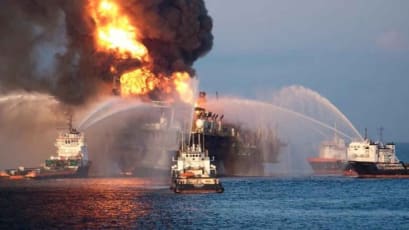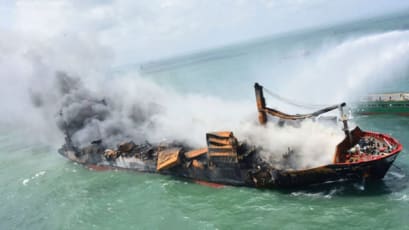Navigating the MT Evoikos spill: advanced response strategies in the Singapore Strait
When two tankers collided in the Singapore Strait in October 1997, what followed was the biggest spill in Singapore waters. OSRL’s response to MT Evoikos’ collision required advanced technical expertise and methodologies for mitigating a major oil spill.
Background
On 16 October 1997, the MT Evoikos, a Very Large Crude Carrier (VLCC), collided with an oil tanker in the Singapore Strait. Approximately 29,000 tonnes of heavy fuel oil spilled into one of the busiest maritime chokepoints in the world. This critical waterway not only supports extensive commercial shipping but also houses sensitive marine habitats and coastal communities across Singapore, Malaysia, and Indonesia. The magnitude of the spill and its location underscored the urgency for a robust, technically proficient response.
Response activation and context of OSRL’s involvement
Local maritime authorities, alongside oil spill response teams from affected regions, initiated the emergency response immediately. Key measures included deploying local containment booms and coordinating a traffic management plan to minimise disruptions in the congested shipping lanes. These actions mitigated the initial spread until OSRL’s specialist teams were mobilised.
OSRL’s participation was requested under the existing regional contingency agreements due to the scale of the spill and its transboundary impact. The immediate deployment included a specialist team of technical advisors, containment and recovery equipment, and aerial surveillance assets.
Main goals and priorities
- Immediate containment to restrict oil spread in heavily trafficked maritime zones.
- Minimise the impact on ecologically critical regions, including mangroves and coral reefs, from contamination.
- Ensure shipping operations in the Singapore Strait resumed swiftly while maintaining safety.
- Facilitate communication across Singapore, Malaysia, and Indonesia to align operational priorities.
Unique challenges
- Heavy maritime traffic: The Singapore Strait’s dense shipping lanes required precise coordination to minimise risks to vessels during cleanup operations.
- Environmental sensitivity: The spill affected coastal mangroves, estuaries, and coral reefs, necessitating site-specific protection plans.
- Cross-border jurisdictions: Managing operational coordination across multiple nations introduced legal and logistical complexities.
- Oil characteristics: The spilled heavy fuel oil’s high viscosity posed challenges in recovery and dispersant efficacy.
Response methodology
OSRL implemented a highly coordinated, multi-phase response:
- Containment:
- Boom deployment: High-capacity booms (offshore and shoreline types) were installed to encircle the slick and protect coastal zones.
- Dynamic anchoring: Innovative anchoring systems stabilised containment setups in shifting tidal conditions.
- Recovery operations:
- Weir and vacuum skimmers: Designed for high-viscosity oil, these systems facilitated the efficient removal of thick oil layers.
- Storage barges: Large-capacity barges were deployed to store recovered oil, preventing additional contamination risks.
- Dispersant application:
- Aircraft-mounted dispersant systems were deployed with precision spraying mechanisms calibrated to oil thickness and sea state.
- Laboratory testing of the oil’s properties ensured chemical dispersants compatibility and environmental safety.
- Aerial surveillance:
- Equipped with SLAR (Side-Looking Airborne Radar) and UV scanners, aircraft conducted real-time mapping of the oil slick’s size, density, and drift patterns.
- Shoreline protection:
- Targeted booms and manual cleanup methods were employed to help protect mangroves and sensitive shorelines.
- Bioremediation trials were conducted on contaminated sediment to accelerate natural degradation processes.
Results
- Over 80% of the spilled oil was recovered within three weeks, significantly mitigating environmental and economic damage.
- High-priority ecosystems, including coral reefs and mangroves, were shielded from severe contamination.
- Cross-border collaboration strengthened regional spill management frameworks and response readiness.
Reflections of Ahmad Hakim Bin Salleh
Evoikos was the biggest spill in Singapore waters. I remember we used a helibucket spray for dispersant application. Helicopters were landing on an open military field in Tuas West. It was also the first time we used the spot spraying method, as we could not use our dispersant aircraft because of the proximity to shore and shipping routes. Due to the size of the spill, it was also the first time the civil defence service had to help with offshore operations, which meant providing training, but quickly, the workers started to experience seasickness due to the long hours at sea. To expedite the clean-up operations, other industry organisations such as AMSA and PIMMAG were also activated. We also worked very long hours as our base had soil erosion problems, and our vessel, at low tide, would sometimes be blocked by another vessel. This meant we had to closely monitor and adjust operations by sailing due to tide times instead of only when it was light. Ultimately, about 40 km of shoreline, including recreation islands, industrial areas and military facilities, was contaminated. After 11 days, we were demobilised.
Key learnings
- Precision technology integration: Advanced equipment and real-time surveillance systems were critical in achieving effective outcomes.
- Regional collaboration: Harmonised response efforts among affected nations demonstrated the value of contingency agreements.
- Adaptability: Rapidly adjusting techniques to environmental and operational conditions was instrumental in minimising damage.
- Specialist resources: The deployment of high-viscosity oil recovery systems underscored the importance of tailored response assets.
Why choose OSRL
With decades of experience and a global team of experts, we provide proven solutions tailored to diverse challenges. Our extensive inventory of specialised equipment and resources enables swift and effective responses to spills of all magnitudes. We collaborate with local organisations and regulatory bodies worldwide, ensuring seamless integration and alignment in response operations. By leveraging the latest advancements in spill response, we continuously enhance our methods and capabilities to address evolving environmental and industry needs.
Want to talk about spill response?
OSRL offers a holistic approach to response, with solutions for offshore, inland and subsea incidents. Our teams are trained to operate in all environments—from remote regions to extreme cold—and bring specialised capability to all aspects of spill response, including areas like oiled wildlife that require specific expertise. Our members get access to technical advisors, our Global Dispersant Stockpile, aviation services, and equipment hire solutions.
Find out more about our Membership options.





